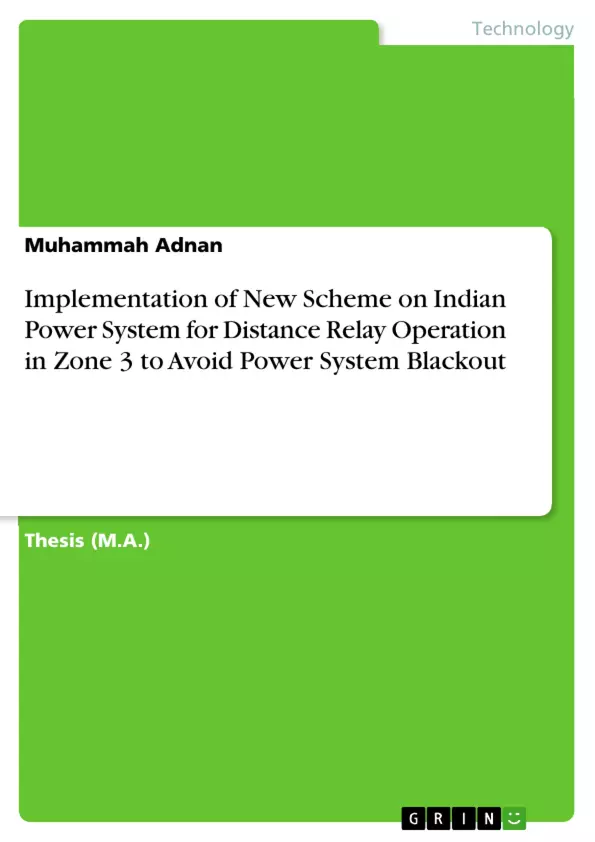In July 2012 there was blackout in India. As the result of this disturbance there were two blackouts. In first blackout only the Northern Grid was affected but in the second blackout Northern, Eastern and North-Eastern grid collapsed. A committee formed by the government analyzed the events that resulted in the collapse of system and pointed out no of factors that lead to disturbance.
Whole grid collapsed under load encroachment condition. In this thesis different factors have been analyzed using PSCAD simulation and solutions have been proposed.
Approximate model of Indian power system has been developed in PSCAD using approximate parameters given in Grid Failure Report issued by the Indian government. Increase in installed capacity of power system and its impact on system frequency and rotor angle has been studied.
A new algorithm has been proposed for distance relay operation in Zone 3 to avoid power system blackout using Indian grid model. One of the main factors that lead to the collapse of whole system was the operation of zone 3 distance relay on 400kV Bina-Gwalior Line. This scheme will improve system stability under heavy load conditions. A simplified model in PSCAD was established in order to study the zone 3 protection of distance relay.
Table of Contents
- CHAPTER. 1 INTRODUCTION OF INDIAN POWER SYSTEM BLACKOUT
- 1.1 Research background and significance
- 1.2 Approximate Model of Indian Grid
- 1.3 Power Flow during Grid Disturbance
- 1.4 Analysis of the Grid Disturbance and Blackout
- 1.4.1 Depletion of Power Transmission Network
- 1.4.2 Frequency Control of System
- 1.4.3 Load Management on Gwalior-Bina Line
- 1.4.4 Flaws in Protection Schemes specifically zone 3
- 1.5 Main Work of This Paper
- CHAPTER. 2 STUDY OF SYSTEM UNDER DIFFERENT CASES AND SOLUTIONS
- 2.1 Introduction
- 2.2 General Situation of Indian Power System
- 2.3 Improvement in System Frequency and Rotor Angle Change because of Thermal Generation in Northern Grid
- 2.3.1 Improvement in System Frequency
- 2.3.2 Change in Rotor Angle
- 2.4 Improvement in system frequency and Rotor Angle Change because of Wind Generation in Western Grid
- 2.4.1 Improvement in System Frequency
- 2.4.2 Change in Rotor Angle
- 2.5 Tripping of Gwalior-Bina Line and System Blackout
- 2.6 Conclusion
- CHAPTER. 3 ZONE THREE PROTECTION
- 3.1 Introduction
- 3.2 Distance Relay Settings of Northern Region and Western Region Line
- 3.3 Power Swing Detection Algorithm
- 3.3.1 System Operation under Normal Conditions
- 3.3.2 System Operation under Power Swing
- 3.3.3 Simulation Results
- 3.4 Synchronous Fault Detection Algorithm
- 3.4.1 System Operation under Synchronous Fault Conditions
- 3.4.2 Simulation Results
- 3.5 Asynchronous Fault Detection Algorithm
- 3.5.1 System Operation under Asynchronous Fault Conditions
- 3.5.2 Simulation Results
- 3.6 Conclusion
- CHAPTER. 4 ADVANCE SCHEME TO AVOID BLACKOUT
- 4.1 Introduction
- 4.2 Power Swing Detection Algorithm
- 4.2.1 Principle of Algorithm
- 4.2.2 Simulation Results
- 4.2.3 Phase Voltage at the Beginning of Line
- 4.3 Three Phase Fault Detection Algorithm
- 4.3.1 Principle of Algorithm
- 4.3.2 Simulation Results
- 4.4 Unbalanced Fault Detection Algorithm
- 4.4.1 Principle of Algorithm
- 4.4.2 Simulation Results
- 4.5 Conclusion
- CHAPTER. 5 SUMMARY AND PROSPECT
- 5.1 Summary
- 5.2 Prospect
Objectives and Key Themes
This dissertation investigates the causes of the 2012 Indian power system blackout and proposes solutions to prevent future occurrences. The study utilizes PSCAD simulations to analyze the performance of the Indian grid under various conditions.
- The impact of increased installed capacity on system frequency and rotor angle
- The role of distance relays in preventing system collapse
- Development of a new algorithm for zone 3 distance relay operation
- Analysis of factors contributing to the grid disturbance and blackout
- Proposed solutions for improving system stability and preventing blackouts
Chapter Summaries
Chapter 1 introduces the Indian power system blackout of 2012, providing background information on the event, the approximate model of the Indian grid, and the power flow during the grid disturbance. The chapter analyzes the factors contributing to the blackout, including the depletion of the power transmission network, frequency control issues, load management problems on the Gwalior-Bina line, and flaws in protection schemes, particularly in zone 3. It concludes by outlining the main objectives of the dissertation.
Chapter 2 investigates the performance of the Indian power system under different load conditions. It analyzes the impact of increased thermal and wind generation on system frequency and rotor angle, and simulates the tripping of the Gwalior-Bina line and the subsequent system blackout.
Chapter 3 explores the concept of zone 3 protection and the importance of distance relay settings. It examines different algorithms for detecting power swings, synchronous faults, and asynchronous faults, presenting simulation results for each scenario.
Keywords
The dissertation focuses on the following key concepts: distance relay, zone 3 protection, system frequency, power swing, load encroachment, Indian power system, blackout, grid stability, PSCAD simulation.
- Arbeit zitieren
- Muhammah Adnan (Autor:in), 2016, Implementation of New Scheme on Indian Power System for Distance Relay Operation in Zone 3 to Avoid Power System Blackout, München, GRIN Verlag, https://www.grin.com/document/339081



